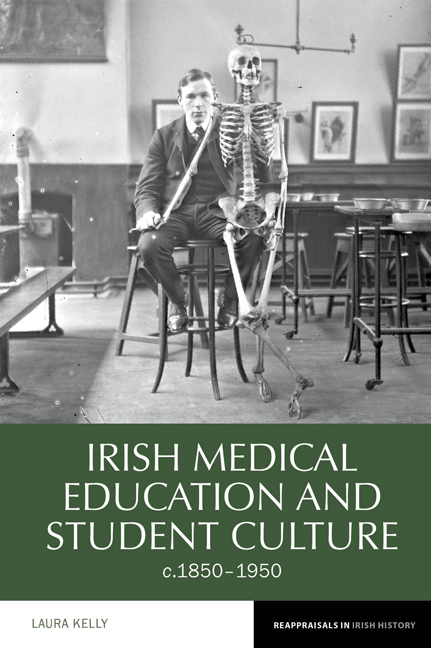Book contents
- Frontmatter
- Contents
- List of Figures
- List of Tables
- Acknowledgements
- List of Abbreviations
- Introduction
- 1 The Medical School Marketplace, c.1850–1900
- 2 ‘Entering upon an Honourable and Important Profession’: Irish Medical Student Image and Representation in the Age of Medical Reform, c.1850–1900
- 3 Beginnings: Medicine and Social Mobility, c.1850–1950
- 4 Educational Experiences and Medical Student Life, c.1880–1920
- 5 ‘Boys to Men’: Rites of Passage, Sport, Masculinity and Medical Student Culture, c.1880–1930
- 6 ‘This Feminine Invasion of Medicine’: Women in Irish Medical Schools, c.1880–1945
- 7 Medical Education and Student Culture North and South of the Border, c.1920–1950 200
- Conclusion
- Bibliography
- Index
Conclusion
- Frontmatter
- Contents
- List of Figures
- List of Tables
- Acknowledgements
- List of Abbreviations
- Introduction
- 1 The Medical School Marketplace, c.1850–1900
- 2 ‘Entering upon an Honourable and Important Profession’: Irish Medical Student Image and Representation in the Age of Medical Reform, c.1850–1900
- 3 Beginnings: Medicine and Social Mobility, c.1850–1950
- 4 Educational Experiences and Medical Student Life, c.1880–1920
- 5 ‘Boys to Men’: Rites of Passage, Sport, Masculinity and Medical Student Culture, c.1880–1930
- 6 ‘This Feminine Invasion of Medicine’: Women in Irish Medical Schools, c.1880–1945
- 7 Medical Education and Student Culture North and South of the Border, c.1920–1950 200
- Conclusion
- Bibliography
- Index
Summary
A piece in Mistura in 1954 explained the transition from student to doctor in the following way:
This mode of life persists until the metamorphosis into ‘Doctor’. This
latter change occurs very suddenly. One moment the Medical Student is standing in a black gown; then he mutters some words under his breath, and lo and behold – ‘Doctor’. ‘Doctors’ are characterised by their brusque manner, lots of money, little hair and by the fact that they never speak to Medical Students.
This book has explored the experiences of medical students studying at Irish universities in the nineteenth and twentieth centuries. Although it is clear that medical education went through some significant changes during this period, with a shift, broadly speaking, from the medical apprenticeship system of the early nineteenth century, to a greater focus on clinical and bedside medicine in the mid-nineteenth century, to attempts to make medicine more scientific in the late nineteenth to early twentieth century, it is clear that medical students of the past and of today share many of the same concerns.
Irish medical schools continue to be ‘exporting schools’. A recent study conducted on emigration and Irish medical graduates found that emigration was on the minds of a significant proportion of the medical student body. Of the 2,273 medical students interviewed, 88 per cent indicated that they were definitely migrating or considering migrating following graduation or completion of their pre-registration intern year, with factors such as career opportunities, working conditions and lifestyle being important factors in their decision to leave. Similarly, a report published by the Royal College of Surgeons in Ireland found that the falling income levels for junior doctors in Ireland, excessive working hours and an uncertain career pathway were important push factors, while the prospect of a better work–life balance in countries such as Australia, New Zealand, the UK and the United States, was an important pull factor.4 Moreover, the introduction of the HPAT (Health Professions Admissions Test) in Ireland in 2009 suggests that the Irish medical profession remains concerned with ensuring that potential students possess what are viewed as being suitable traits. The test, which has generated much debate since its introduction, assesses the suitability of potential medical students by assessing their logical and non-verbal reasoning as well as inter-personal understanding. Additionally, it is clear that women have made significant progress in the Irish medical profession.
- Type
- Chapter
- Information
- Irish Medical Education and Student Culture, c.1850–1950 , pp. 243 - 247Publisher: Liverpool University PressPrint publication year: 2017



